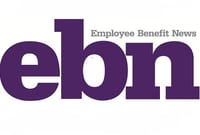 Retirement plan sponsors can reap significant rewards from the automated, two-way flow of retirement savings accounts into and out of plans. This “automated portability” spawns important downstream benefits for sponsors—but sponsors can only capture them by choosing to recycle mandatory distributions rather than continuing to dump them into an already sizable landfill of micro-balance safe harbor IRAs (see Employee Benefit News previous blog post titled Why Dump Mandatory Distributions In A Landfill When You Can Recycle?). This article focuses on one of those benefits—the decrease in plan costs obtained through the increase in a plan’s average account balance.
Retirement plan sponsors can reap significant rewards from the automated, two-way flow of retirement savings accounts into and out of plans. This “automated portability” spawns important downstream benefits for sponsors—but sponsors can only capture them by choosing to recycle mandatory distributions rather than continuing to dump them into an already sizable landfill of micro-balance safe harbor IRAs (see Employee Benefit News previous blog post titled Why Dump Mandatory Distributions In A Landfill When You Can Recycle?). This article focuses on one of those benefits—the decrease in plan costs obtained through the increase in a plan’s average account balance.
Decreasing Costs via Two-Way Flows
By utilizing automated portability to both systematically roll in previous retirement account balances (“stranded accounts”) for active participants and weed out the small accounts of separated participants, sponsors can increase their plans’ average account balances. In a clear case of cause and effect, industry research demonstrates a correlation between higher average account balances and lower fees for plans.
A study conducted by Deloitte Consulting for the Investment Company Institute found that in 2013, the U.S. defined contribution system’s median “all-in fee” (the combination of a sponsor’s recordkeeping, administrative and investment management fees as a percentage of plan assets) was lower for plans with higher average account balances. According to the study, a 10% increase in a plan’s average account balance can shave 2.2 basis points off of its sponsor’s all-in fee.
The study, released in August 2014, reported that the connection between higher average account balances and lower fees is present in both smaller and larger plans. For example, the median all-in fee for plans with between $1 million and $10 million in total assets was 1.29%, if their average account balances were $25,000. However, the median all-in fee for those plans with average account balances of between $25,000 and $100,000 was 1.03%. The median all-in fee for $1 million to $10 million plans with average account balances of over $100,000 was even lower—0.96%.
This trend also manifested among plans with $500 million or more in total assets. Plans in that universe with average account balances of $25,000 had a median all-in fee of 0.43%, while those with average account balances of between $25,000 and $100,000, and over $100,000, had median all-in fees of 0.39% and 0.29%, respectively.
Within Easy Reach
A plan’s average account balance is a key metric used by recordkeepers and other service providers to evaluate its health. Increasing it can give sponsors the leverage they need to negotiate lower fees. The automated portability which makes this possible is not a “pie in the sky” concept—sponsors can take advantage of a variety of integrated technology solutions to facilitate the two-way movement of retirement accounts for their plans.
The tools to achieve automated portability—and the lower fees that come with it—already exist. To make the dream a reality, all sponsors need to do is work with their recordkeepers to adopt a mandatory distribution program that enables an automated a two-way flow of retirement accounts.
